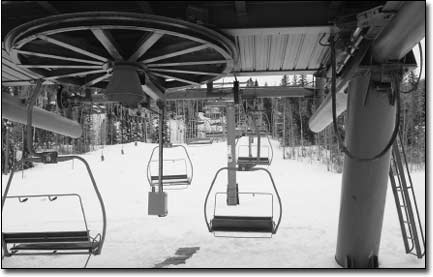|
Resorts taking concrete steps to reduce their impacts

|
|
DMR’s Graduate Lift awaits action earlier this season. In the face of
global warming, the resort, like others in Colorado, is taking steps to
reduce the use of fossil fuels by using biodiesel and encouraging carpooling./
Photo by Todd Newcomer
|
Although by no means in lock-step, more ski area operators are acknowledging global warming. Skiing and snowboarding, they concede, are threatened by rising temperatures. Less directly, ski area operators also acknowledge they and their customers are part of the problem.
Locally, significant and numerous steps are being taken at Durango Mountain Resort to lessen emissions. According to Matt Skinner, DMR communications director, a significant improvement in greenhouse gas benefit has been realized over the past year at the resort as a result of a large reduction in solid waste and transportation demand.
"We've made great strides in our environmental programs, and take pride in being one of the most environmentally progressive resorts in the industry," Skinner says. "Our current programs and master plan are designed to set the environmental standard for La Plata County."
Specifically, Skinner notes that, thanks to employee education, more efficient collection processes and resort wide recycling efforts, the volume of trash sent to the landfill was reduced by a massive 25 percent in the last year. He explained that DMR also provides recycling containers for all of north La Plata County to use.
The resort also has worked to reduce vehicle miles traveled by employees, according to Skinner. Last season, a streamlined bus service and a new employee carpool program reduced vehicle miles by 330,000. Skinner also explained that DMR has begun a pilot biodiesel program for use in vehicles and machinery. DMR is one of only two resorts in Colorado to use biodiesel in on-mountain machinery (the other is Aspen). The resort snowmobile fleet also is being phased in to four-stroke machines. The resort expects that both programs will further reduce fossil fuel usage and corresponding greenhouse gases over the next year.
Aspen first
The first resort in the ski industry to publicly embrace the science that predicts global warming was the Aspen Skiing Co. "It's probably been about five years, at the time of our first sustainability report, when we decided to reduce our emission of greenhouse gases," says Pat O'Donnell, Aspen's chief executive officer.
At first, the company focused only on its own role, not so much as a polluter of the air, but instead as a customer of electricity that is primarily produced by coal-fired power plants. For example, it began retrofitting lighting fixtures with compact fluorescent light bulbs, which use less power than conventional incandescent bulbs.
Two years ago, the company more boldly began trying to persuade other companies and industries to embrace changes. "I don't think you can do that until you have your own house relatively straightened up," O'Donnell explains.
O'Donnell's essential message is that the warmer temperatures now being predicted are not that far off. "It's hard to look that far, but `that far' comes pretty quickly," he says. "I've been in the industry for three decades, and it comes at the blink of an eye."
Keep Winter Cool
Most significant has been the shifted stance of the National Ski Areas Association. Just a few years ago the Lakewood-based organization didn't want to touch the issue of long-term climatic change. But in 2003, NSAA launched its first "Keep Winter Cool" promotional campaign.
"Keep Winter Cool" is delicately crafted. It has a happy face that, without bogging down in the science, says future skiing depends upon reducing greenhouse gas emissions. It also tells people how they can lessen their contribution to creating greenhouse gases. And finally, it highlights what ski-area operators themselves are doing, such as DMR's use of biodiesel in its snow cats.
In quiet, deliberate ways, the program acknowledges the ski industry's dependence upon the use of fossil fuels. After all, if ski areas themselves do not have smoke stacks, they are major buyers of electricity from coal-burning plants that do. To that end, the "Keep Winter Cool" program now describes efforts to reduce those emissions in terms of carbon dioxide per skier visit. It's a glass-half-full analysis that nonetheless suggests how ski area operators could do better.
But the ski industry sees its most powerful role as a catalyst for changing others. "I think we are a leader in bringing attention to the issue," says Geraldine Link, NSAA's director of public policy.
Quietly prodded by Aspen, NSAA has even more boldly organized the support of 70 ski areas for a bill now in Congress. Co-sponsored by two former presidential candidates, Republican John McCain, of Arizona, and Democrat Joseph Lieberman, of New Jersey, the bill proposes to limit emissions of greenhouse gases by regulation. The bill got 43 votes and hence failed, but will likely be reintroduced this next session.
- Allen Best
|